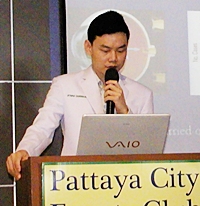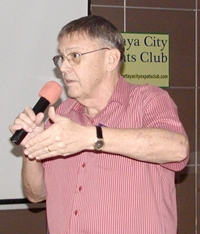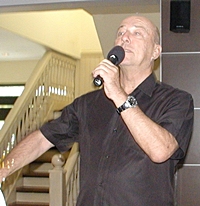A leading cause of blindness if left untreated is glaucoma. This was the message to the Pattaya City Expats Club at their Sunday meeting on January 15. Master of Ceremonies Roy Albiston introduced Dr. Jittapan Chureeganon, M.D., an Ophthalmologist with Bangkok Hospital Pattaya (BHP) to talk about the risk factors and detection of glaucoma. BHP also had a nurse providing free blood pressure checks for members and guests.
Dr. Jittapan received his Doctor of Medicine from the Faculty of Medicine of Chulalongkorn University in 2004. He received his Diplomate from the Thai Board of Ophthalmology in 2010 and performed his Residency in Glaucoma at Chulalongkorn Hospital during 2010 and 2011.
 Dr. Jittapan explains the danger of high Intra Ocular Pressure (IOP) in causing glaucoma, and how it is measured with a Tonometer.
Dr. Jittapan explains the danger of high Intra Ocular Pressure (IOP) in causing glaucoma, and how it is measured with a Tonometer.
Dr. Jittapan started his presentation by displaying a comparative picture that showed how the same object would appear to those whose vision was normal, with intermediate symptoms, and advanced symptoms of glaucoma. He explained that glaucoma is a group of eye conditions that lead to damage to the optic nerve. He showed a diagram and described how the optic nerve, which carries visual information from the eye to the brain, can be damaged by glaucoma. In most cases, damage to the optic nerve is due to increased pressure in the eye, also known as intraocular pressure.
The front part of the eye is filled with a clear fluid. It leaves the eye through channels in the front of the eye in an area called the anterior chamber angle, or simply the angle. Anything that slows or blocks the flow of this fluid out of the eye will cause pressure to build up in the eye. In most cases of glaucoma, this pressure is high and causes damage to the optic nerve. He described the four major types of glaucoma: Open-angle (chronic), Angle-closure (acute), Congenital, and Secondary.
 Board member David Meador explains how to get to Froggy’s French Bistro, the ‘Frugal Freddy’ restaurant for Monday, hosted by Hawaii Bob Sutterfield.
Board member David Meador explains how to get to Froggy’s French Bistro, the ‘Frugal Freddy’ restaurant for Monday, hosted by Hawaii Bob Sutterfield.
Open-angle (chronic) glaucoma is the most common type of glaucoma representing about 95% of cases. The cause is unknown and it results in an increase in eye pressure slowly over time. The pressure pushes on the optic nerve. Dr. Jittapan pointed out that this type of glaucoma initially has no symptoms; once vision loss occurs, the damage is already severe. As it progresses, there is a slow loss of side (peripheral) vision (also called tunnel vision).
Angle-closure (acute) glaucoma occurs when the exit of the fluid is suddenly blocked. This causes a quick, severe, and painful rise in the pressure in the eye. Dr. Jittapan said that this type of glaucoma is an emergency. Symptoms develop quickly and medical attention should be sought as it needs immediate treatment. Symptoms may come and go at first, or steadily become worse. Symptoms are: sudden, severe pain in one eye, decreased or cloudy vision, nausea and vomiting, rainbow-like halos around lights, red eye, and/or the eye feels swollen.
Congenital glaucoma is seen in babies, juveniles, or young adults. It often runs in families and is present at birth. It is caused by abnormal eye development. Secondary glaucoma can be caused by drugs such as corticosteroids, eye diseases, systemic diseases, and trauma.
The most common risk factors are: (1) age over 40 years old; (2) having a history of ocular pressure; (3) having a family history of glaucoma; (4) having diabetes; (5) had eye surgery; (6) having a history of using steroids; or (7) having migraine headaches, snoring, or diabetic neuropathy. Dr. Jittapan also said that people of African and Asian descent are at high risk.
 MC for the day, Roy Albiston invites new visitors to introduce themselves to Pattaya City Expats Club, before he himself introduces Dr. Jittapan Chureeganon, M.D., an Ophthalmologist with Bangkok Hospital Pattaya (BHP), to talk about the risk factors and detection of Glaucoma.
MC for the day, Roy Albiston invites new visitors to introduce themselves to Pattaya City Expats Club, before he himself introduces Dr. Jittapan Chureeganon, M.D., an Ophthalmologist with Bangkok Hospital Pattaya (BHP), to talk about the risk factors and detection of Glaucoma.
He said a complete eye exam is usually needed to diagnose glaucoma. You may be given an eye drop to widen (dilate) your pupil. Another test called tonometry is done to check eye pressure. Some other tests can include: using a special lens to look at the eye (gonioscopy), photographs or laser scanning images of the inside of the eye (optic nerve imaging), examination of the retina in the back of the eye, and visual field measurement.
Treatment will vary depending on diagnosis as to the severity of the damage. This can include medicine therapy, laser treatment, and surgery. He concluded his presentation by using a video vision simulator which allowed him to adjust for types and severity. With each adjustment, the picture would change to reflect how the vision would be affected. He said that the important thing to remember about glaucoma is that there are often no symptoms, so periodic examinations should be made especially if you have any of the risk factors. If left untreated glaucoma can lead to blindness. In the USA, it is the second leading cause of blindness.
After Dr. Jittapan answered many questions from the audience, Roy Albiston called on Pat Koester to update everyone on upcoming events and to conduct the Open Forum where questions are asked and answered about expat living in Thailand and Pattaya in particular. The Pattaya City Expats Club meets every Sunday at the Amari Orchid’s Tavern by the Sea Restaurant. Read more about the club’s activities on their website at www.pattayacityexpatsclub.com.




